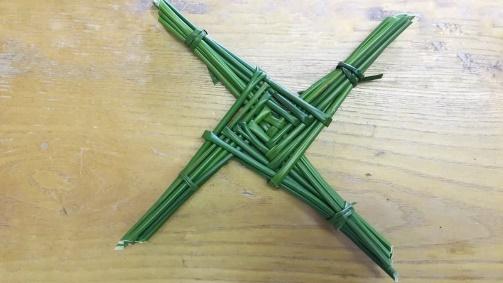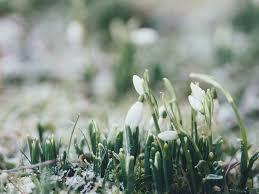Greetings All,
I hope that you’re all heartened by the slow but unmistakable lengthening of the days as January slips into February. In December, my husband and I bundled up late afternoons to watch the sun set beyond the coastal hills at 4:30. Now this happens at 5:30. Light is returning.
As I write this, we find ourselves between the first full moon of the year, traditionally known as the Wolf Moon, and the obscure yet delightful Celtic holiday of Imbolc in early February. The Wolf Moon above was photographed on January 25 at the Gran Sasso massif in Abruzzo, Italy. It takes its name from winters past in the Northern Hemisphere when wolves were driven by hunger to leave their usual remote habitats, drawing closer to humans with their flocks and herds as potential sources of food.
Spiritually, the Wolf Moon invites solitary introspection on the one hand, and re-connection to home, hearth, and relational bonds on the other. This duality is borne out by the biological traits of wolves as highly social, collaborative, and loyal creatures whose survival nevertheless depends on the dispersal of younger males from the pack. Lone wolves roam far from the territory of their birth, sometimes for years, searching for an outside mate. In this way they prevent overhunting and foster genetic diversity within the species. The wolf as a totem encourages us to gather, share, and comfort one another in winter, as well as to cultivate independence, tenacity, and courage—to do what needs to be done.
Winter is a season of storytelling, and one of the traditional tales told around the fires of the Algonquian peoples of the Northern Woods, Great Lakes, and central Canada has been that of the Wendigo. The Wendigo (below) is associated with winter and described as a ravenous, demonic being with glowing eyes, sharp fangs, and a heart of ice who pursues and devours humans or possesses their spirits, causing them to turn into cannibals. The more the Wendigo consumes the more famished it becomes, tortured by its own appetite and sometimes even chewing off its own lips or other body parts in a futile attempt to satisfy its hunger. It personified the ravages of extreme cold and hunger at a time when surviving harsh northern winters necessitated banding together and sharing what scant resources were available.

(Photo/medium.com)
It’s said that the greedy and selfish are most likely to be possessed by the Wendigo, as well as those weakened and consumed by hunger. Interpretations of the Wendigo myth include the reinforcement of vital values of moderation and cooperation; an expression of the taboo against violence, murder, and cannibalism in times of severe winter famine; and, post-colonially, as a metaphor for the insatiability of white settlers laying waste to indigenous people and the natural world.
Roughly translated, Wendigo means “the evil spirit that devours humankind” and as such (stay with me here while I pivot to another wisdom tradition) is a stark dramatization of the craving and attachment Buddhism understands as one of the primary causes of human suffering. The Noble Eight-Fold Path, the Buddha’s foundational guide for those following the dharma, includes the precept of Wise or Right Action, which advises generosity and abstaining from what is not freely given. This precept is aligned with Algonquian values that supported the pre-colonial sustainability of northern First Nation people and the natural resources they relied upon: ask; do not take more than is given; and always leave some behind, with the Wendigo as a vivid parable about the consequences of violating these sacred principles.
To balance this dark story, we can turn to the ancient Celtic festival of Imbolc, also known as Candlemas or St. Brigid’s Day. Imbolc occurs halfway between the winter solstice and the vernal equinox. In pre-industrial times, this coincided with lambing season and the consequent availability of sheep’s milk. Lambs came before calves, and their arrival meant sheep’s milk for consumption and an end in sight to the deprivations of winter.
The celebration of Imbolc is based on early pagan customs with a Christian veneer. In the pantheon of pagan deities, Cailleach, the hag of winter, dominates the dark months, while the maidenly goddess Brede (later Bridget) presides over the light half of the year. Traditional observances include the fashioning of “Crosses of St. Brigid,” whose shape combines the later Christian cross with the pagan sun wheel motif, to bring health and protection to the maker. Candles are lit to honor the growing light; and handmade St. Brigid dolls decorated with cloth, shells, and crystals. Snowdrops are another important symbol of the holiday, evoking as the earliest, winter-flowering bulb the promise of spring.


What hardships have you faced this winter, and what is supporting you to navigate them? Where has solitude been calling to you, and when do you feel most grateful for the presence of others? Anticipating the arrival of spring, what hopeful wishes do you hold and how can these be cultivated? How can considering the cyclical and seasonal nature of life illuminate and enrich your experience?
We’ll be considering these questions and more later this month through guided meditation, written reflection, storytelling, and discussion as we delve into the literal and metaphorical meanings of winter and prepare to welcome the spring season. I’ll be offering a continuation of my online series on the natural wisdom of the seasons, Four Seasons of Mindfulness: Winter on Tuesday, February 28th from 6 – 7:30 pm PST. I’d love to share this event with you and hope that you’ll join me. To register, please click on the link below:
Meanwhile, extending wishes that the stirring of life underground
brings new dreams and energy to you that take root and grow in the lengthening days.
Andrea
